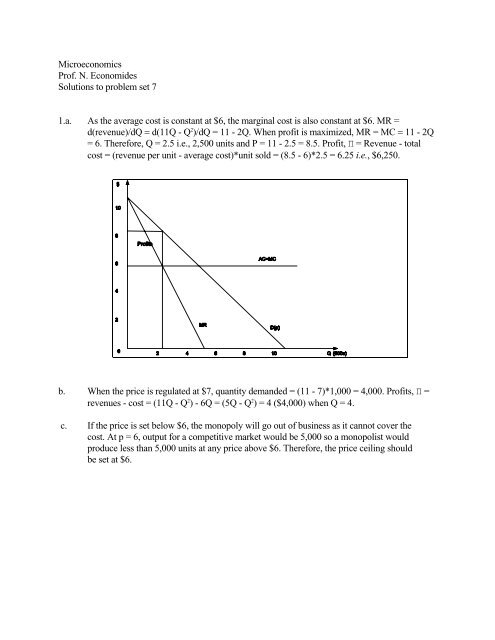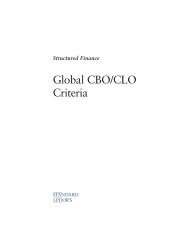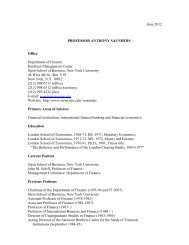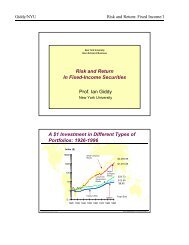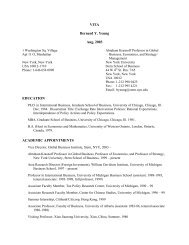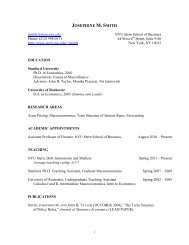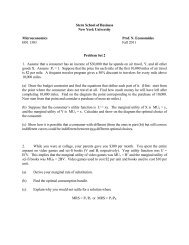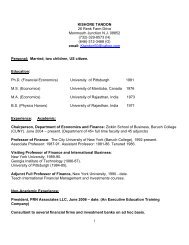Solution to problem set 7 - NYU Stern School of Business
Solution to problem set 7 - NYU Stern School of Business
Solution to problem set 7 - NYU Stern School of Business
You also want an ePaper? Increase the reach of your titles
YUMPU automatically turns print PDFs into web optimized ePapers that Google loves.
Microeconomics<br />
Pr<strong>of</strong>. N. Economides<br />
<strong>Solution</strong>s <strong>to</strong> <strong>problem</strong> <strong>set</strong> 7<br />
1.a. As the average cost is constant at $6, the marginal cost is also constant at $6. MR =<br />
d(revenue)/dQ = d(11Q - Q 2 )/dQ = 11 - 2Q. When pr<strong>of</strong>it is maximized, MR = MC = 11 - 2Q<br />
= 6. Therefore, Q = 2.5 i.e., 2,500 units and P = 11 - 2.5 = 8.5. Pr<strong>of</strong>it, Π = Revenue - <strong>to</strong>tal<br />
cost = (revenue per unit - average cost)*unit sold = (8.5 - 6)*2.5 = 6.25 i.e., $6,250.<br />
b. When the price is regulated at $7, quantity demanded = (11 - 7)*1,000 = 4,000. Pr<strong>of</strong>its, Π =<br />
revenues - cost = (11Q - Q 2 ) - 6Q = (5Q - Q 2 ) = 4 ($4,000) when Q = 4.<br />
c. If the price is <strong>set</strong> below $6, the monopoly will go out <strong>of</strong> business as it cannot cover the<br />
cost. At p = 6, output for a competitive market would be 5,000 so a monopolist would<br />
produce less than 5,000 units at any price above $6. Therefore, the price ceiling should<br />
be <strong>set</strong> at $6.
2a. Revenue = price*quantity. Since price = 120 - y, revenues = p*y = (120 - y)*y = 120y - y 2 .<br />
Marginal revenue = change in revenue/change in quantity = d(120y - y 2 )/dy = 120 - 2y. To<br />
maximize pr<strong>of</strong>its, monopolist produces where MR = MC ⇔120 - 2y = 2y ⇔ y = 30. Price =<br />
120 - y, so p = 90. Pr<strong>of</strong>its = R - C = 30*90 - 30 2 = 2700 - 900 = $1,800.<br />
b. Revenues remain unchanged, but c(y) = y 2 + 100. MC = d(y 2 + 100)/dy = 2y. Since this is the<br />
same as in a), the monopolist would not change his level <strong>of</strong> output from y = 30. Pr<strong>of</strong>its are<br />
still positive at $1,700, so the monopolist would not shut down.<br />
c. Surplus is maximized at the level <strong>of</strong> output reached in competitive equilibrium, when the<br />
supply and demand curves intersect. This occurs where MC = price consumers are willing <strong>to</strong><br />
pay. Thus, 2y = 120 - y, and y =40. Price = 120 - y = 80.<br />
d. y = 40, as shown in part c.<br />
e. Now c(y) = y 2 + 20y, so MC' = 2y + 20. Setting MR = MC', 120 - 2y = 2y + 20 or y = 25, p =<br />
95.
3. Referring <strong>to</strong> the graph, MC 2 intersects with the MR curve but MC 1 doesn’t. Therefore, only<br />
MC 2 is relevant. As the demand curve is P = 20 - 3Q, then, MR = 20 - 6Q. At pr<strong>of</strong>it maximization,<br />
MR = MC ⇔ 20 - 6Q = 10 + 5Q ⇔ 11Q = 10 and Q = 10/11 and the price = 20 - 3(10/11) = 190/11<br />
= 17.3.


